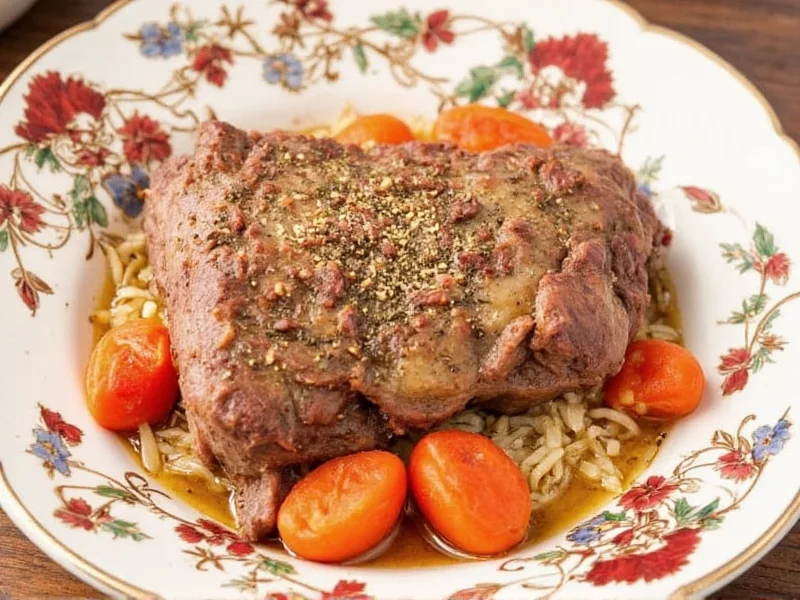Understanding what's inside that small envelope can transform your pot roast from ordinary to extraordinary. While convenient, store-bought pot roast seasoning packets vary significantly between brands in both ingredient quality and flavor balance. Knowing exactly what you're working with helps you adjust recipes for perfect results every time.
What's Really Inside Pot Roast Seasoning Packets
Most commercial pot roast seasoning packets contain a standardized blend designed for consistency rather than culinary excellence. The typical components include:
| Common Ingredients | Purpose in Pot Roast | Typical Percentage |
|---|---|---|
| Salt | Flavor enhancement, moisture retention | 40-60% |
| Onion powder | Savory base flavor | 15-25% |
| Garlic powder | Aromatic depth | 10-20% |
| Thyme and rosemary | Herbal complexity | 5-10% |
| Cornstarch or flour | Thickening agent | 10-15% |
The high salt content explains why many home cooks find their pot roast too salty when following package directions precisely. Most packets contain between 1,200-1,800mg of sodium—nearly a full day's recommended intake. This knowledge helps you adjust liquid ratios and additional seasoning when using these convenient packets.
Maximizing Flavor with Store-Bought Seasoning Packets
Professional chefs rarely use pot roast seasoning packets straight from the envelope. Instead, they employ these techniques to elevate the basic mix:
- Add acid: Stir in 1-2 tablespoons of red wine vinegar or Worcestershire sauce to brighten flavors
- Boost umami: Mix in 1 teaspoon of tomato paste or soy sauce for deeper savory notes
- Freshen herbs: Double the dried herbs with fresh counterparts during the last hour of cooking
- Adjust salt: Reduce added salt by 50% if using a full packet, especially with store-bought broth
For best results when using a pot roast seasoning packet, brown your meat thoroughly first. The Maillard reaction creates complex flavor compounds that interact beautifully with the seasoning mix. Add the packet contents after deglazing the pan with liquid, scraping up all those flavorful browned bits.
Homemade Pot Roast Seasoning Packet Alternatives
Creating your own pot roast seasoning blend gives you complete control over ingredients and sodium levels. This basic recipe makes enough for one 3-4 pound roast:
- 2 tablespoons onion powder
- 1½ tablespoons garlic powder
- 1 tablespoon dried thyme
- 1 tablespoon dried rosemary (crushed)
- 2 teaspoons black pepper
- 1½ teaspoons paprika
- 1 teaspoon celery seed
- ½ teaspoon cayenne (optional)
Unlike commercial pot roast seasoning packets, this homemade version contains no added salt or thickeners. This gives you flexibility to adjust sodium to taste and control your gravy consistency separately. Store unused portions in an airtight container for up to six months.
Common Pot Roast Seasoning Mistakes to Avoid
Even experienced cooks make these errors when using pot roast seasoning packets:
- Adding all liquid at once: Pour in only enough liquid to cover the bottom third of the meat. Too much liquid dilutes flavors and prevents proper braising.
- Not adjusting for packet salt content: If your packet contains salt (most do), reduce additional salt in the recipe by at least 75%.
- Adding seasoning too late: Incorporate the seasoning mix during the deglazing step to allow flavors to meld throughout cooking.
- Ignoring meat quality: No seasoning packet can compensate for poor quality meat. Choose well-marbled chuck roast for best results.
Remember that pot roast seasoning packets work best as flavor foundations rather than complete solutions. The magic happens when you understand their limitations and enhance them with fresh ingredients and proper technique.
Troubleshooting Pot Roast Flavor Issues
Rescue your pot roast when using seasoning packets with these fixes:
- Bland flavor: Add 1 teaspoon of Dijon mustard and 2 sprigs of fresh thyme during the last hour of cooking
- Overpowering saltiness: Add peeled potato chunks to absorb excess salt, or dilute with unsalted broth
- Lack of depth: Stir in 1 tablespoon of tomato paste and ½ cup of dry red wine
- Weak gravy: Mix 2 tablespoons cornstarch with equal parts cold water, then stir into simmering liquid
These adjustments work whether you're using a store-bought pot roast seasoning packet or your own homemade blend. The key is tasting and adjusting throughout the cooking process rather than waiting until the end.











 浙公网安备
33010002000092号
浙公网安备
33010002000092号 浙B2-20120091-4
浙B2-20120091-4